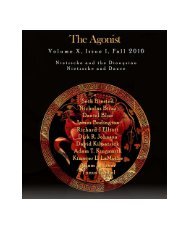Volume XII, Issue II, Spring 2019
Create successful ePaper yourself
Turn your PDF publications into a flip-book with our unique Google optimized e-Paper software.
THE AGONIST<br />
confluence of influences, from Empedocles and Holderlin to Paul Rée. However,<br />
Prideaux ultimately weighs in on the side of a practical and physiological<br />
explanation: his style was a necessity of his illness, “the only way he was capable<br />
of recording the bursts of significant thought between headaches” (p.184).<br />
Although previous biographies have provided detailed treatments on the matter<br />
of Nietzsche’s suffering, I am Dynamite! displays it with a rich physicality that keep<br />
the reader meditating on the presence of the illness that played a constitutive part<br />
of Nietzsche’s life and work.<br />
Unlike Safranski and Young, Prideaux does not attempt to write a<br />
philosophical biography. She devotes relatively few pages to expositions of<br />
Nietzsche’s thought. Likewise her book does not aim to be as comprehensive as<br />
Cate’s. There are whole years to which she gives only a cursory glance (1886-1888<br />
receives just thirteen pages of attention). She touches on, but does not dwell upon,<br />
the Oedipal nature of Nietzsche’s love for the Wagners. All these themes have<br />
already been well explored. The point upon which Prideaux surpasses previous<br />
biographers is in her attunement to the emotional life of Nietzsche. Her careful<br />
observation of Nietzsche’s habits and his moods, her speculation upon their<br />
changes and origins, is the strongest aspect of I am Dynamite!. Prideaux’s biography<br />
does the difficult work of portraying the complexity of Nietzsche’s anxiety and<br />
pain, the intensity of his desire and aspirations, and thereby helps us feel closer<br />
than ever before to Nietzsche as he lived and breathed. Prideaux’s previous work<br />
in biographies on the lives of Edvard Munch and August Strindberg, and her<br />
extensive research into the social etiquette and discontents of the late 19th<br />
century, contributes an impressive background which shapes her inquiry.<br />
A detailed account like Prideaux’s of Nietzsche’s emotional odyssey is an<br />
eminently worthwhile project. To explore what Nietzsche was feeling would be<br />
one of the most genuine ways to write about the thinker on his own terms.<br />
Nietzsche would be the first to assert that his philosophical battles with<br />
Christianity, with Wagner, and with modernity were ultimately shaped by aspects<br />
of his emotional life. “Thoughts are the shadows of our feelings—always darker,<br />
emptier, simpler” (GS §179). Prideaux helps to emphasize that, due in large part<br />
to his extraordinary illness, Nietzsche had a deeper affective understanding of<br />
these problems than previous philosophers.<br />
The biography’s emotionally oriented narrative does lead to an occasional<br />
tendency towards exaggeration. For instance on p.311 Prideaux states that<br />
Nietzsche “had no companions during his time in Turin. Not even any visitors.”<br />
While the overall point Prideaux is makes is an important one––that Nietzsche<br />
established for himself a genuine sense of urban solitude in Turin––it is not quite<br />
accurate to say he did not have any company. He did at least become acquainted<br />
62









